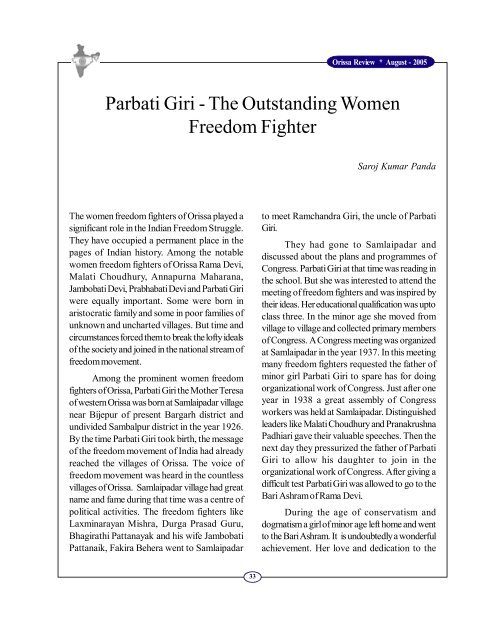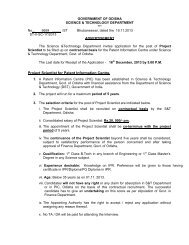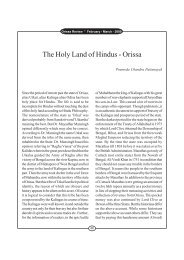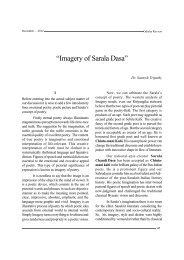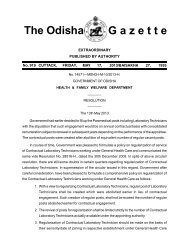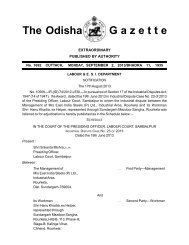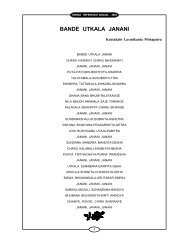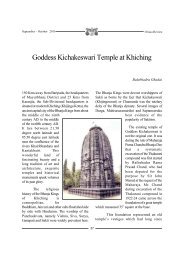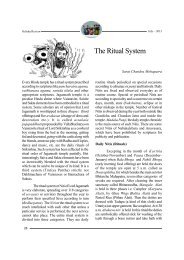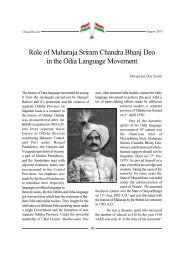Parbati Giri - Government of Orissa
Parbati Giri - Government of Orissa
Parbati Giri - Government of Orissa
You also want an ePaper? Increase the reach of your titles
YUMPU automatically turns print PDFs into web optimized ePapers that Google loves.
The women freedom fighters <strong>of</strong> <strong>Orissa</strong> played a<br />
significant role in the Indian Freedom Struggle.<br />
They have occupied a permanent place in the<br />
pages <strong>of</strong> Indian history. Among the notable<br />
women freedom fighters <strong>of</strong> <strong>Orissa</strong> Rama Devi,<br />
Malati Choudhury, Annapurna Maharana,<br />
Jambobati Devi, Prabhabati Devi and <strong>Parbati</strong> <strong>Giri</strong><br />
were equally important. Some were born in<br />
aristocratic family and some in poor families <strong>of</strong><br />
unknown and uncharted villages. But time and<br />
circumstances forced them to break the l<strong>of</strong>ty ideals<br />
<strong>of</strong> the society and joined in the national stream <strong>of</strong><br />
freedom movement.<br />
Among the prominent women freedom<br />
fighters <strong>of</strong> <strong>Orissa</strong>, <strong>Parbati</strong> <strong>Giri</strong> the Mother Teresa<br />
<strong>of</strong> western <strong>Orissa</strong> was born at Samlaipadar village<br />
near Bijepur <strong>of</strong> present Bargarh district and<br />
undivided Sambalpur district in the year 1926.<br />
By the time <strong>Parbati</strong> <strong>Giri</strong> took birth, the message<br />
<strong>of</strong> the freedom movement <strong>of</strong> India had already<br />
reached the villages <strong>of</strong> <strong>Orissa</strong>. The voice <strong>of</strong><br />
freedom movement was heard in the countless<br />
villages <strong>of</strong> <strong>Orissa</strong>. Samlaipadar village had great<br />
name and fame during that time was a centre <strong>of</strong><br />
political activities. The freedom fighters like<br />
Laxminarayan Mishra, Durga Prasad Guru,<br />
Bhagirathi Pattanayak and his wife Jambobati<br />
Pattanaik, Fakira Behera went to Samlaipadar<br />
33<br />
<strong>Orissa</strong> Review * August - 2005<br />
<strong>Parbati</strong> <strong>Giri</strong> - The Outstanding Women<br />
Freedom Fighter<br />
Saroj Kumar Panda<br />
to meet Ramchandra <strong>Giri</strong>, the uncle <strong>of</strong> <strong>Parbati</strong><br />
<strong>Giri</strong>.<br />
They had gone to Samlaipadar and<br />
discussed about the plans and programmes <strong>of</strong><br />
Congress. <strong>Parbati</strong> <strong>Giri</strong> at that time was reading in<br />
the school. But she was interested to attend the<br />
meeting <strong>of</strong> freedom fighters and was inspired by<br />
their ideas. Her educational qualification was upto<br />
class three. In the minor age she moved from<br />
village to village and collected primary members<br />
<strong>of</strong> Congress. A Congress meeting was organized<br />
at Samlaipadar in the year 1937. In this meeting<br />
many freedom fighters requested the father <strong>of</strong><br />
minor girl <strong>Parbati</strong> <strong>Giri</strong> to spare has for doing<br />
organizational work <strong>of</strong> Congress. Just after one<br />
year in 1938 a great assembly <strong>of</strong> Congress<br />
workers was held at Samlaipadar. Distinguished<br />
leaders like Malati Choudhury and Pranakrushna<br />
Padhiari gave their valuable speeches. Then the<br />
next day they pressurized the father <strong>of</strong> <strong>Parbati</strong><br />
<strong>Giri</strong> to allow his daughter to join in the<br />
organizational work <strong>of</strong> Congress. After giving a<br />
difficult test <strong>Parbati</strong> <strong>Giri</strong> was allowed to go to the<br />
Bari Ashram <strong>of</strong> Rama Devi.<br />
During the age <strong>of</strong> conservatism and<br />
dogmatism a girl <strong>of</strong> minor age left home and went<br />
to the Bari Ashram. It is undoubtedly a wonderful<br />
achievement. Her love and dedication to the
<strong>Orissa</strong> Review * August - 2005<br />
society forced her father to give permission. There<br />
was no good communication system at that time.<br />
So it was a daring feat by a girl who had gone<br />
from a small and insignificant village like<br />
Samlaipadar to Bari Ashram <strong>of</strong> Jajpur. <strong>Parbati</strong><br />
<strong>Giri</strong> left home on 14th January 1938. At that time<br />
Prabhabati Devi, another girl (child widow) <strong>of</strong><br />
Bargarh also agreed to go with <strong>Parbati</strong> <strong>Giri</strong>. The<br />
family members <strong>of</strong> Prabhabati also tried to<br />
convince both the girls to return home. But their<br />
efforts turned in vain. Inspite <strong>of</strong> all such obstacles<br />
they proceeded to Bari Ashram. On the way, they<br />
halted at Arigaon in the home <strong>of</strong> Reba Roy. In<br />
the next day they reached the Bari Ashram. Both<br />
<strong>of</strong> them met Rama Devi, Gopabandhu Choudhury<br />
and others.<br />
The Ashram <strong>of</strong> those days were established<br />
on high moral value system, which cannot be<br />
compared with modern Ashram. Those Ashrams<br />
were called "Sangrami Sibira" and "Ahimsa<br />
tirtha". Gopabandhu Choudhury was also a<br />
remarkable man. He resigned from the post <strong>of</strong><br />
Deputy Collector by the call <strong>of</strong> Mahatma Gandhi<br />
and dedicated himself for the freedom struggle.<br />
So young <strong>Parbati</strong> <strong>Giri</strong> was directly inspired by<br />
the ideas <strong>of</strong> Gopabandhu Choudhury and Rama<br />
Devi and equally influenced by Mahatma Gandhi.<br />
During her life in the Ashram, <strong>Parbati</strong> <strong>Giri</strong> had<br />
done commendable work and extended her love<br />
and affection to all. She learned many things in<br />
Bari Ashram, which helped her in later stage. In<br />
the year 1940, direct Satyagraha started. All the<br />
Ashrams came to the known as Sangrami Sibira<br />
and the borders were the freedom fighters.<br />
<strong>Parbati</strong> <strong>Giri</strong> returned back to her village and did<br />
Congress work in Bargarh, Sambalpur,<br />
Padampur, Panimara, Ghens etc. At that time<br />
<strong>Parbati</strong> <strong>Giri</strong> did not stay in her home. She moved<br />
from village to village, and organized meetings<br />
against the alien rule. She gave training <strong>of</strong> weaving<br />
34<br />
and thread making in villages like Samlaipadar,<br />
Barpali, Panimora, Sarandapali and Dalaipara <strong>of</strong><br />
Sambalpur town. When <strong>Parbati</strong> <strong>Giri</strong> came to<br />
Sambalpur she stayed with Kamala Devi, the<br />
mother <strong>of</strong> Sraddhakar Supakar. She actively<br />
participated in the Khadi Andolon <strong>of</strong> Mahatma<br />
Gandhi.<br />
The Quite India Movement was started in<br />
the year 1942. The thunderous sound <strong>of</strong> this<br />
movement was reflected in countless villages <strong>of</strong><br />
<strong>Orissa</strong>. The prominent villages where pioneers <strong>of</strong><br />
freedom movement were born are Samlaipadar,<br />
Panimara, Ghens etc. The following persons such<br />
as Ramachandra <strong>Giri</strong>, Ujjal <strong>Giri</strong>, Dwitiya <strong>Giri</strong>,<br />
Kuber <strong>Giri</strong>, Mangal <strong>Giri</strong> and Dwadesi Rana were<br />
taken as prisoners and sent to Bargarh jail.<br />
Once young <strong>Parbati</strong> <strong>Giri</strong> accompanied with<br />
a group <strong>of</strong> boys and gave anti-British slogans.<br />
But due to her minor age, the police personnels<br />
were unable to arrest her. Next day <strong>Parbati</strong> <strong>Giri</strong><br />
with three boys arrived in the <strong>of</strong>fice <strong>of</strong> SDO at<br />
Bargarh during the time <strong>of</strong> Quite India Movement.<br />
<strong>Parbati</strong> <strong>Giri</strong> the young girl got up to the chair <strong>of</strong><br />
S.D.O. and acted as a judge. Another boy played<br />
the role <strong>of</strong> an advocate and other became peon.<br />
At that time SDO entered into the <strong>of</strong>fice and<br />
young <strong>Parbati</strong> <strong>Giri</strong> ordered the peon to bring the<br />
culprit tied with a rope. The police personnels<br />
surrounded the young girl in the Court and tried<br />
to get her down from the chair. Due to her antigovernment<br />
activities, she was imprisoned for two<br />
years. Her internal aim was to resist the imperialist<br />
and colonial rule <strong>of</strong> the Britishers.<br />
Another remarkable event in the life <strong>of</strong><br />
<strong>Parbati</strong> <strong>Giri</strong> occurred at Bargarh Court. She had<br />
gone to the Bargarh Bar where the lawyers had<br />
sat. The pre-matured girl ordered the lawyers to<br />
vacate the Court. Her aim was to non-cooperate<br />
the British <strong>of</strong>ficials in legal matters. Some lawyers
left the court and those who did not vacate were<br />
given two bangles (chudi) each as presentation.<br />
From that incident the valour and courage <strong>of</strong><br />
<strong>Parbati</strong> <strong>Giri</strong> was clearly known. She has done so<br />
many reformative work in her lifetime and has<br />
been inspired by the high ideals <strong>of</strong> Gandhi. She<br />
was a glaring star <strong>of</strong> <strong>Orissa</strong>.<br />
<strong>Parbati</strong> <strong>Giri</strong> came from an unknown village<br />
<strong>of</strong> western <strong>Orissa</strong>. But by dint <strong>of</strong> her<br />
achievements, she has occupied a unique place<br />
not only in the history <strong>of</strong> <strong>Orissa</strong> but also in the<br />
history <strong>of</strong> India. She was not only a freedom<br />
fighter but also an ideal social reformer. Her<br />
service to the destitute and orphans has boldly<br />
established her name. She was not only an<br />
outstanding personality but also an institution by<br />
herself.<br />
35<br />
References:<br />
<strong>Orissa</strong> Review * August - 2005<br />
1. Banhikanya, Er. Jugal Kishor Mohapatra, First<br />
Edition, 1995, Burla, Five Star Press, (Oriya).<br />
2. Krushna Chandra Panda, Antaranga Alekshya,<br />
First Edition. 1997, Badabazar, Sambalpur.<br />
3. <strong>Parbati</strong> <strong>Giri</strong> Smruti Committeee, Hatibari,<br />
Smaranika 19th January, 1998 named as "Smruti<br />
Sourav" Ed.Trimurti Printer, Badabazar,<br />
Sambalpur.<br />
4. <strong>Parbati</strong> <strong>Giri</strong>, M.Phil. Dissertation submitted to<br />
P.G. Dept. <strong>of</strong> History, Sambalpur University by<br />
Miss Basanti Kujur in the year 1994.<br />
Saroj Kumar Panda is a Lecturer in History, <strong>Parbati</strong> <strong>Giri</strong><br />
College, Mahulpali in the district <strong>of</strong> Sambalpur.<br />
ACTIVITIES OF SCIENCE & TECHNOLOGY DEPARTMENT<br />
1. Establishment <strong>of</strong> a State-wide Communication Network under Gramsat Pilot Project<br />
linking the State headquarters with all the 30 district headquarters, 314 block headquarters<br />
and 1087 Gram Panchayat headquarters in 8 KBK Districts. Conducting more than 300<br />
Interactive Training Programmes by the User Departments and NGOs. Commencement<br />
<strong>of</strong> broadcasting<strong>of</strong> evening transmission from 6.00 P.M. to 7.15 P.M. on developmental<br />
programmes since 27.7.2004 in all days except Sundays.<br />
2. Preparation <strong>of</strong> a Directory <strong>of</strong> Oriya Scientists released by Hon'ble Chief Minister, <strong>Orissa</strong><br />
on 19.7.2005.<br />
3. Preparation <strong>of</strong> Advantage <strong>Orissa</strong> Document on Biotechnology through the Biotech<br />
Consortium India Ltd. (BCIL), New Delhi.<br />
4. Organisation <strong>of</strong> an Investors' Meet on Biotechnology on 4.7.2005 in association with the<br />
Biotech Consortium India Ltd. (BCIL), New Delhi and I.I.T., Kharagpur.<br />
5. Establishment <strong>of</strong> a Medicinal Plant Research Centre at Jeypore <strong>of</strong> Koraput district by<br />
the M.S. Swaminathan Research Foundation in collaboration with the State <strong>Government</strong>.<br />
6. Establishment <strong>of</strong> a Renewable Energy Awareness Park at Bhubaneswar at Kharavela<br />
Park.<br />
7. Establishment <strong>of</strong> 'Regional Hardening Facility' at the Regional Plant Resource Centre,<br />
Bhubaneswar with the assistance <strong>of</strong> <strong>Government</strong> <strong>of</strong> India.


